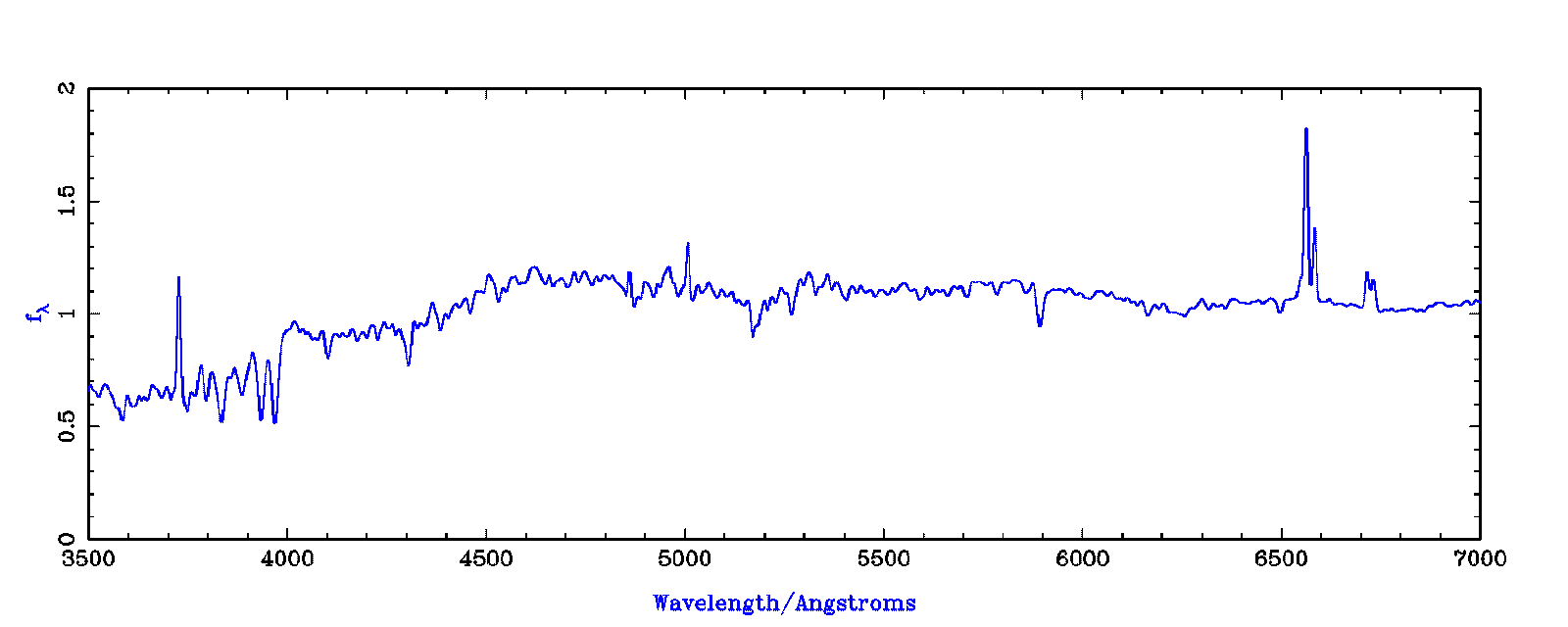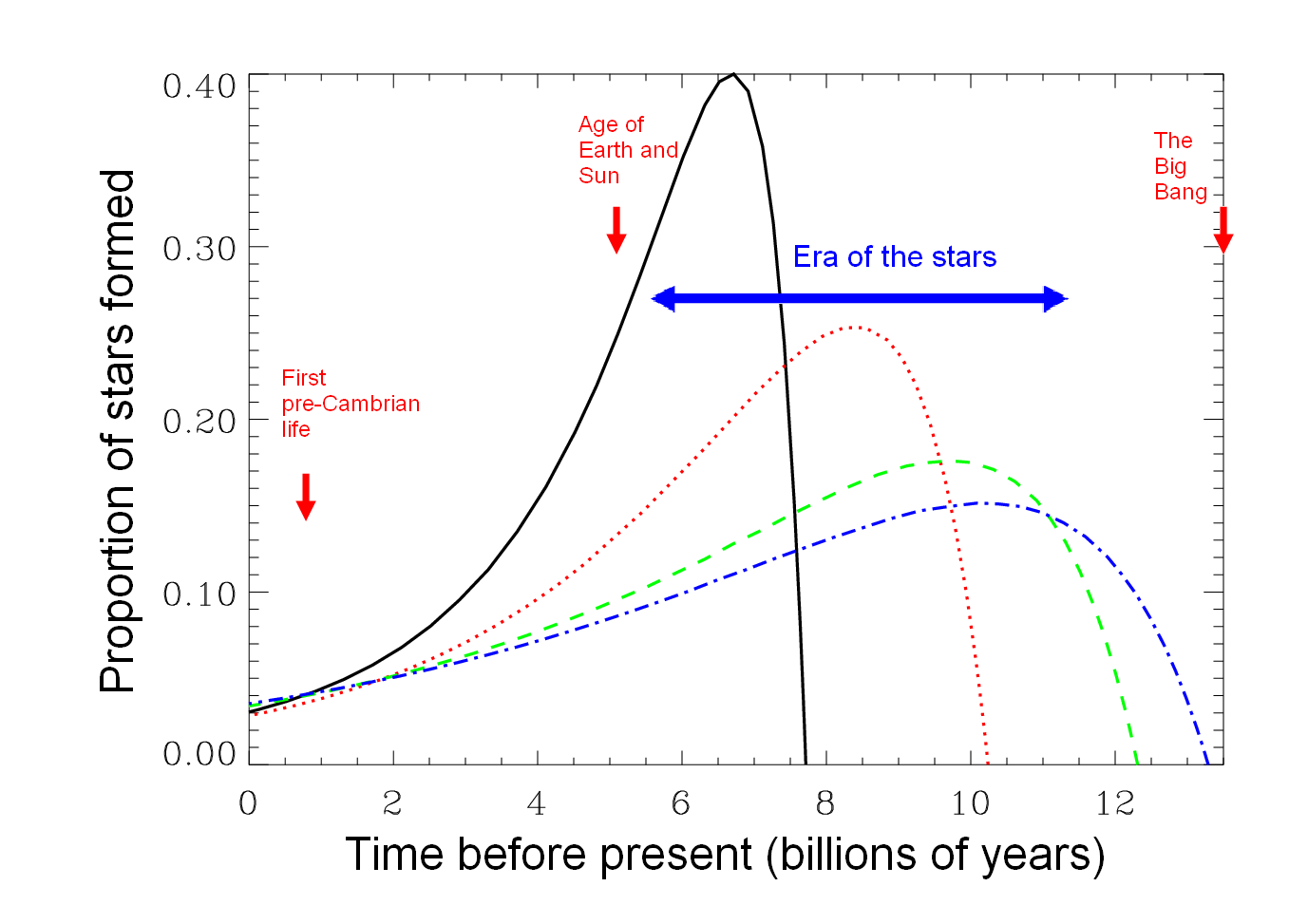
However using the 2dF Galaxy Redshift Survey - a new survey of more than 200,000 galaxies which measures the light from a large volume of the Universe - we have recently been able to try and answer this question. We have constructed what we call "The Cosmic Spectrum", which represents all the energy in the local universe emitted at different optical wavelengths of light. This is what the cosmic spectrum looks like:

This is a graph of the energy emitted in the Universe for different wavelengths of light. Blue light is on the left and red light is on the right. This is constructed by adding together all the individual spectra of the separate galaxies in the 2dF survey. The sum represents the light of all the stars. We believe that because the 2dF survey is so large (reaching out several billion light years) that this spectrum is truly representative. We can also show the cosmic spectrum this way:

Here we have put in the color the eye would see at each wavelength of light. You can think of this as what the eye would see if we put all the light in the Universe through a prism to produce a rainbow. The intensity of the color is in proportion to it's intensity in the Universe.
So what is the average color? We can answer this question by taking the cosmic spectrum and computing the red-green-blue response of the human eye to all the light. This would be the color you would see if you were to view all the light in the Universe together. And here it is:

The color is quite close to the standard shade "Pale Turquoise" although it is a few per cent greener (the eye can easily tell). The RGB values are 0.269, 0.388, 0.342. By eye the color appears to lie between "medium aquamarine" and "pale turquoise", here is a comparison:

The total level of brightness is of course arbitrary, in fact we can calculate the whole range from dark to light to give a range of perceptual shades:

Of course we have more motive for calculating the cosmic
spectrum that just producing these pretty color pictures. In fact the cosmic
spectrum tells us about the history of star-formation in the Universe. You
may have noticed above that the cosmic spectrum contains dark lines and bright
bands, these correspond to the characteristic emission of different
elements:

The strength of the dark lines is determined by the temperatures of the stars contributing to the cosmic spectrum. Older stars have cooler atmospheres and produce a different set of lines to hot young stars. By analyzing the spectrum we can work out the relative proportions of these and try and infer what the star-formation rate was in past ages of the Universe. The gory details of this analysis is given in Baldry, Glazebrook, et al. 2002. A simple picture of our inferred most likely histories of star-formation in the Universe is shown here:

All these models give the correct cosmic spectrum in the 2dF
survey and all of them say that the majority of stars in the Universe today
formed more than 5 billion years ago. This of course implies that the color of
the Universe would have been different in the past when there were more hot
young blue stars. In fact we can calculate what this would be from our best
fitting model. The evolution of the color with time looks like this:

The universe started out young and blue, and grew gradually greener as the population of evolved red stars built up. The rate of formation of new stars has declined precipitously in the last 6 billion years due to the decline in reserves of interstellar gas for forming new stars. As the star-formation rate continues to decline and more stars become red giants the color of the Universe will become redder and redder. Eventually all stars will disappear and nothing will be left but black holes. These too will eventually evaporate via the Hawking process and nothing will be left except for old light, which will itself redden as the Universe expands forever (in the current cosmological model).
This work was based on the 2dF Galaxy Redshift Survey of which we are team members. Our work was supported by the David & Lucille Packard Foundation. We used the information and software from John Walker's excellent Web page 'Color Rendering of Spectra' to compute these colors from our spectra. Fortunately the Universe is (currently) within the displayable RGB gamut!